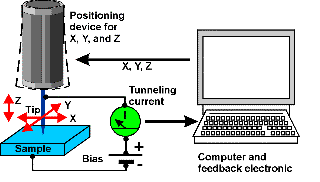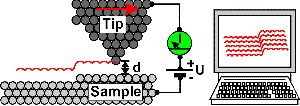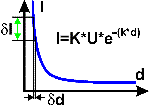Scanning Tunneling Microscopy
Basic Concept

Schematic illustration of the scanning tunneling microscope
The sample is positively or negatively biased so that a small current, the "tunneling current" flows if the tip is in contact to the sample. This feeble tunneling current is amplified and measured. With the help of the tunneling current the feedback electronic keeps the distance between tip and sample constant. If the tunneling current exceeds its preset value, the distance between tip and sample is increased, if it falls below this value, the feedback decreases the distance. The tip is scanned line by line above the sample surface following the topography of the sample.
Tunneling Current

The tip-sample tunneling contact |

Exponential law |
The reason for the extreme magnification capabilities of the STM down to the atomic scale is mainly the physical properties of the tunneling current.
The tunneling current flows across the small gap that separates the tip from the sample, a case that is forbidden in classical physics but that can be explained by the better approach of quantum mechanics. The tunneling current I has a very important caracteristic: it exhibits an exponentially decay with an increase of the gap d:
I= K*U*e -(k*d); k and K are constants.
Very small changes in the tip-sample separation induce large changes in the tunneling current!
This has the consequences that:
- The tip-sample separation can be controlled very exactly
- The tunneling current is only carried by the outermost tip atom; the atoms that are second nearest carry only an negligible amount of the current: The sample surface is scanned by a single atom!
Tunneling Tip
The question I am asked most is "How do you obtain these wonderful tunneling tips where only one atom is at the top?" But it is really easy to obtain such tips by etching or tearing a thin metal wire. I often use the following comparison: Imagine pouring a bucket of sand on the floor. If you examine the resulting conic heap in most cases you will find a grain of sand that represents the outermost peak. Very seldomly you will have several grains exactly representing the peak together. Now take the heap of sand for the tip and remember the exponential decay of the tunneling current. The tunneling current is carried and the sample surface will be scanned only by this outermost grain of sand... sorry: atom.
Atomic Manipulation
Using the tip of a scanning tunneling microscope as a tool, atoms which are adsorbed on a surface can be moved and thereby assembled to artificial nanostructures. This is done in the following way : (i) A constant current image is taken in order to determine the positions of all atoms. During this imaging, the tip is rather far from the atoms and therefore the atoms are unaffected. (ii) The tip is moved closer to one of the atoms by changing the tunneling parameters current and voltage. Thereby, this particular atom is partly bound to the tip. (iii) Keeping these tunneling parameters, the tip is moved to the desired position and the atom follows the tip. (iv) Another constant current image is taken in order to check the new position of the manipulated atom.
The film shows the sequence of constant current images taken during the construction of the logo of the university of Hamburg from 21 iron atoms adsorbed on the (111) surface of copper.
